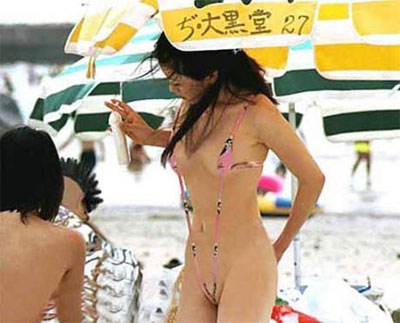| Hot Topics | |
|---|---|
'Itfs swimsuit doping!'
42 posts
• Page 1 of 2 • 1, 2
("We only use Japanese makers") plus
(Japanese makers lack the latest technology) =
Poetic muhfuckin' justice!
(Japanese makers lack the latest technology) =
Poetic muhfuckin' justice!
"If there's a river, we'll dam it, and if there's a tree, we'll ram it - 'cause we Japanese are talkin' progress!"
-

Catoneinutica - Posts: 1953
- Joined: Tue Jan 24, 2006 12:23 pm
That guy is trippin'...as if Japanese swimsuit makers could even make a comparable suit in the time left until the Summer Games...I'm sure Speedo invested considerable time and money in their R&D efforts for the LZR. It's not as if they whipped it out on an Etch-a-sketch.
What an aho.
What an aho.
- 2triky
- Maezumo
- Posts: 2513
- Joined: Fri Oct 28, 2005 7:50 am
Asahi: Japanese denied 'high-tech doping' Speedos
Shiori Ogawa rose from obscurity in March by setting a Japanese junior high school swimming record in the women's 800-meter freestyle. But much of the attention was focused on her outfit. Ogawa was wearing a high-tech swimsuit developed by British sportswear maker Speedo International Ltd. The success of international competitors using Speedo outfits has been so astounding that Speedo's rivals are calling the swimwear "high-tech doping." Whether the swimsuit gives an unfair advantage is open for debate. But swimmers on Japan's Olympic team will not get the chance to find out first-hand. They are under contract to wear swimsuits produced by three domestic makers...Of 37 world swimming records set so far this year, 35 were by swimmers wearing the Speedo swimsuits...Since the tie-up between Mizuno and Speedo ended last year, Japanese makers have faced growing demands from top swimmers to develop original technology. But Japanese swimwear designers say they have already run out of technological ideas...more...
-

Mulboyne - Posts: 18608
- Joined: Thu May 06, 2004 1:39 pm
- Location: London
Tsuru wrote:Right, no more swimsuits.
Hehehe. I hope your right....(leers at the monitor in anticipation of the swiming events!)
"There are those that learn by reading. Then a few who learn by observation. The rest have to piss on an electric fence and find out for themselves!"- Will Rogers

-

Greji - Posts: 14357
- Joined: Fri Jun 25, 2004 3:00 pm
- Location: Yoshiwara
That would kind of make it like women's water polo.
There were some pics of this on Google images but perhaps they aren't appropriate on FG.
There were some pics of this on Google images but perhaps they aren't appropriate on FG.
His [Brendan Behan's] last words were to several nuns standing over his bed, "God bless you, may your sons all be bishops."
-

Behan - Maezumo
- Posts: 1824
- Joined: Tue Aug 22, 2006 4:15 pm
- Location: That Wonderful Place Known as Chiba
Australian: Japan enters race to make world's fastest swimsuit
A JAPANESE fabric maker says it has made the world's fastest swimsuit to rival Speedo's record-breaking LZR Racer suit. Japan's Olympic swimmers, obliged to wear their own country's products, have been in uproar over the LZR Racer, going as far as to liken its use to doping because of the advantage it gives wearers. Now Japan's Yamamoto Corp., which has supplied a super-fast synthetic rubber fabric to wetsuit makers around the world, has come to the rescue with the Olympic Games just three months away. The company has offered material, called the Biorubber Swim-SCS Fabric, to challenge Britain's Speedo, saying it is the "the world's fastest swimwear material." "The decision is not aimed at all at business. It's aimed at helping Japanese swimmers fight to their heart's content in fair conditions at the Beijing Olympics," said the company's president, Tomizo Yamamoto. The rubber maker said it has sent samples to Japan's three main sporting attire makers -- Mizuno, Asics and Descente. The Japan Swimming Federation has given the three until May 30 to come up with an upgrade to counter Speedo.
The federation requires its swimmers, who include Olympic breaststroke champion Kosuke Kitajima, only to wear products by one of the three companies. Yamamoto's fabric is coated with synthetic rubber that absorbs water molecules into its honeycomb surface, unlike most other materials which repel them. Its surface is smoothed out with water molecules to minimise frictional resistance. Japan has set a goal of winning a total of five medals at the Olympics in August across all disciplines, including in the pool. But Japanese swimmers have been alarmed by the LZR Racer since its debut in February, with the suit accounting for 18 of the 19 new world records since then. "We want to erase fears among the swimmers. We have requested the three companies to match Speedo," said Kazuo Sano, the swimming federation's executive director. Tomiaki Fukuda, chief of the Japanese delegation to the Beijing Games, lashed out at other sports leaders for limiting the choice to Japanese brands. "Why can't we use the (Speedo) swimsuit when we know it's fast," Fukuda shouted at a recent meeting, according to media reports.
Yamamoto said its Biorubber fabric has already been used, primarily for triathlon events. In October, swimwear by New Zealand brand Blue Seventy which used the fabric was approved by the international swimming federation FINA for its official meets, he said. Other suit makers, including Xterra of the United States, Australia's 2XU, Aquaman of France and New Zealand's Orca have also adopted the material, Yamamoto said. Five collegiate swimmers at Japan's Kansai University shaved their times by 1.0-2.0 seconds in 50 metres after switching to the Biorubber Swim fabric, he said.
The LZR Racer was developed with the help of the US space agency NASA. It uses a high-tech fabric of water-resistant polyurethane and is structured to squeeze the swimmer's body into the right posture. FINA endorsed its use last month. When Japanese Olympic swimmers tested the LRZ Racer last month, one of them improved his time for the first 15 metres by 0.7 seconds, said swimming federation official Norimasa Hirai. "I can imagine that in general the (Speedo) product means a difference of 0.5 seconds over 100 metres and one second over 200 metres," Hirai said. All three Japanese makers said they would consider the Yamamoto fabric. "Yamamoto's is one of our options," said Mizuno spokesman Fumihiko Sawai. "We are definitely prepared to produce the best available."
-

Mulboyne - Posts: 18608
- Joined: Thu May 06, 2004 1:39 pm
- Location: London
They might not need Yamamoto's fabric:
Reuters: Japanese swimmers could do U-turn on bodysuits
Reuters: Japanese swimmers could do U-turn on bodysuits
.Japan's swimmers could ditch their existing swimsuit makers and wear Speedo's space-age LZR bodysuit at this year's Beijing Olympics. Japanese officials paved the way for an abrupt U-turn by announcing that swimmers could test the controversial Speedo suit at an Olympic send-off competition next month. "We haven't set any limitations (on what suits swimmers can wear)," Japan Swimming Federation (JSF) executive director Kazuo Sano told Wednesday's Japanese media. "It's a competition for all those swimmers going to the Olympics. They may wear Speedo suits if they wish. We still have options"...JSF officials are scheduled to make a final ruling on the issue on June 10, following the Japan Open competition in Tokyo. Kitajima, who won gold medals in the 100 and 200 meters breaststroke in Athens four years ago, is preparing to test a new improved Mizuno suit this weekend
-

Mulboyne - Posts: 18608
- Joined: Thu May 06, 2004 1:39 pm
- Location: London
Sounds like the Japan swimming federation is shitting in their boots. If they don't come home with any medals, they would be in big trouble. So what do they do, jettison the official sponsors and go with the winning suit. I'm not sure that Asics , and the others will be too happy about the change, but national pride is too important.
Jacques Plante: "How would you like a job where, every time you make a mistake, a big red light goes on and 18,000 people boo?"
-

canman - Maezumo
- Posts: 1765
- Images: 0
- Joined: Thu Jul 25, 2002 11:08 pm
- Location: Hachinohe
canman wrote:Sounds like the Japan swimming federation is shitting in their boots. If they don't come home with any medals, they would be in big trouble. So what do they do, jettison the official sponsors and go with the winning suit. I'm not sure that Asics , and the others will be too happy about the change, but national pride is too important.
The Japanese teams could stick a fire cracker up their bums and piggy back a dolphin, but that still won't improve their chances against the Aussies and the Americans.
In the beginning the universe was created. This has made a lot of people very angry and been widely regarded as a bad move - Douglas Adams
-

Midwinter - Maezumo
- Posts: 649
- Joined: Thu Mar 10, 2005 10:06 pm
Midwinter wrote:The Japanese teams could stick a fire cracker up their bums and piggy back a dolphin, but that still won't improve their chances against the Aussies and the Americans.
So true!
I will not abide ignorant intolerance just for the sake of getting along.
-

American Oyaji - Posts: 6540
- Images: 0
- Joined: Sun Oct 20, 2002 9:20 pm
- Location: The Evidence of Things Unseen
The solution to the whole problem is make all Olympic swimmers swim nude, the hot female ones, that is.
-

Doctor Stop - Maezumo
- Posts: 1837
- Joined: Tue Jan 16, 2007 10:12 pm
- Location: Up Shit Creek Somewhere
Yamamoto's fabric is coated with synthetic rubber that absorbs water molecules into its honeycomb surface, unlike most other materials which repel them. Its surface is smoothed out with water molecules to minimise frictional resistance.
i think i saw this during the 15 minutes of j-tv i'm subjected to daily while i wolf down dinner (so i don't have to endure listening to mother and father-in-law chewing with their mouths open). i think they were saying it was the same material that coats those hotplates they use to make tako-yaki.
"Cause I'm stranded all alone, in the gas station of love, and I have to use the self-service pumps.."
- "Weird Al" Yankovic
- "Weird Al" Yankovic
-

james - Posts: 1829
- Images: 1
- Joined: Fri Oct 22, 2004 9:21 am
- Location: off the deep end
SwimmingWorld: Kosuke Kitajima Elects Not To Test New Suit, Japanese Brands Strive to Improve by Deadline
IN a college dual meet at the Tokyo Tatsumi International Swimming Center, Kosuke Kitajima certainly had a chance to test one of the improved models supplied by Mizuno, but he elected not to. In the morning race of the 200-meter breaststroke, he appeared with the same suit from the Olympic Trials in April and finished in an easy form of 2:15.10. Later in the afternoon in 100-meter, Kitajima finished in 1:00.82. As he did not test any new suit, strategic meaning of his appearance today became very shallow. Kitajima neither revealed why he did not test a new suit nor talked too much about the issue of swimsuits. "I just hear good things about the LZR Racer," Kitajima said in a press conference. "It is natural that I have an interest in it. But, even people not swimming related now ask a lot of questions. It is bothering me."
"The sample was made and handed over to Kosuke just yesterday," a Mizuno spokesperson said. "There are other options but still nothing concrete has been decided within the company." Kitajima's teammate Reiko Nakamura experimented with a Speedo LZR Racer today in both 100 and 200 backstroke. She went 1:00.02 in the 100 and 2:09.95 in 200. "Competing, I thought it was going to be about high 60 seconds but obviously it was better than that," Nakamura said about her 100. "They are in heavy training now and yet managed to swim fair times," Kitajima and Nakamura's coach Norimasa Hirai said. "I could see effectiveness of the suits."
Meanwhile, at the Santa Clara International Invitational, Yukihiro Okumura broke the Japanese record in the men's 200 freestyle with a 1:47.70 leadoff leg in the men's 800 freestyle relay. He was testing the Speedo LZR Racer, and in Japan, more than his Japanese record, what he was wearing got more attention. Eventually, these occurrences are tightening the options for the Japanese Swimming Federation, and might force them to review the contents of their exclusive contract with Mizuno, Asics and Descente, which distributes the Arena brand in Japanese market. The federation says it will make a final decision on the use of the other brands of swimsuits at the 2008 Beijing games on June 10.
-

Mulboyne - Posts: 18608
- Joined: Thu May 06, 2004 1:39 pm
- Location: London
Yomiuri: Are swimmers dressed for success?
...The JSF must take the blame for the series of swimsuit disputes because they resulted from its failure to keep up with the latest developments in global swimsuit design and technology. Though the federation previously had a committee tasked with obtaining and analyzing the latest swimsuit design trends in other countries, it was abolished in 2005. Consequently, the federation has since failed to systematically study training methods in other countries and developments in swimsuit design. Last year, Michael Phelps, an American who won six gold medals at the 2004 Athens Olympics, and several other swimmers set world records wearing the previous model of the LZR swimsuit. However, a majority of members in the JSF apparently were unaware of the swimsuit's role in establishing better records.
It was only recently that federation members began pointing out the need to scientifically examine swimsuits. "It may be necessary in future for those who are responsible for training and medical science to study [the role swimsuits play in setting records]," said Kazuo Sano, the federation's executive director. According to Shinji Higashijima, former chairman of the JSF's committee monitoring foreign swimsuit technology, Phelps' coach told him last year about the superiority of the LZR swimsuit. "The coach told me that [Phelps] discovered he could use a dolphin kick longer in the second half of a race, saying that it was partly because of the swimsuit's features," Higashijima said.
At that time, some countries were already looking at using the superior Speedo product, but the Japanese federation failed to consider using it until recently. "Mizuno, Descente and Asics have supported Japan's swim team in various aspects even back when the sport didn't receive much interest from the public," an executive of the federation said. "We can't ignore the support we've received." However, the JSF will no doubt be criticized by Japanese swimmers if it bans them from wearing the new Speedo swimsuit because the federation has contracts with the three Japanese manufacturers...more...
-

Mulboyne - Posts: 18608
- Joined: Thu May 06, 2004 1:39 pm
- Location: London
Mulboyne wrote:Yomiuri: Are swimmers dressed for success?
Original Japanese: "...... "Mizuno, Descente and Asics have supported Japan's swim team in various aspects even back when the sport didn't receive much interest from the public," an executive of the federation said. "We can't ignore the support we've received." ....."
Translation: "....As long as they keep back channeling me that cold cash, I don't care if they sell us BVDs for them to swim in...."
"There are those that learn by reading. Then a few who learn by observation. The rest have to piss on an electric fence and find out for themselves!"- Will Rogers

-

Greji - Posts: 14357
- Joined: Fri Jun 25, 2004 3:00 pm
- Location: Yoshiwara
The new Japan women's swim team uniform
Greji, how this one.

Hamaki

Hamaki
-

Hamaki - Maezumo
- Posts: 53
- Joined: Mon May 12, 2008 6:57 pm
- Location: Near Ikebukuro
Hamaki wrote:Greji, how this one.
Hamaki
If you mean this one, I'll take her and the money....

"There are those that learn by reading. Then a few who learn by observation. The rest have to piss on an electric fence and find out for themselves!"- Will Rogers

-

Greji - Posts: 14357
- Joined: Fri Jun 25, 2004 3:00 pm
- Location: Yoshiwara
Greji wrote:If you mean this one, I'll take her and the money....
Wow, talk about less is more.
Is there a story, or something else, behind it or her?
His [Brendan Behan's] last words were to several nuns standing over his bed, "God bless you, may your sons all be bishops."
-

Behan - Maezumo
- Posts: 1824
- Joined: Tue Aug 22, 2006 4:15 pm
- Location: That Wonderful Place Known as Chiba



The three Japanese swimsuit companies have come up with their final attempts to match Speedo. The swimming team will try them out and decide on June 10th whether to use them or try to break their contract and go with Speedo suits.
-

Mulboyne - Posts: 18608
- Joined: Thu May 06, 2004 1:39 pm
- Location: London
Mulboyne wrote:Bad news for the Japanese manufacturers: Takeshi Matsuda has just set a new national record for the men's 200m butterfly and Haruka Ueda has done the same for the women's 200m freestyle. Both were wearing Speedo suits.

"When robbery is done in open daylight by sanction of the law, as it is done today, then any act of honor or restitution has to be hidden underground." -Ayn Rand 'Atlas Shrugged'
-

Visitor K - Maezumo
- Posts: 428
- Joined: Tue Feb 08, 2005 10:51 am
- Location: bucharest, romania
Speedo suits have just been approved. (Japanese). The three Japanese manufacturers will remain the official suppliers but swimmers will be free to select an approved costume which now includes Speedo.
-

Mulboyne - Posts: 18608
- Joined: Thu May 06, 2004 1:39 pm
- Location: London
Mulboyne wrote:Speedo suits have just been approved. (Japanese). The three Japanese manufacturers will remain the official suppliers but swimmers will be free to select an approved costume which now includes Speedo.
Well that'll be a really tough choice, won't it?
-

Gilligan - Maezumo
- Posts: 1029
- Joined: Fri May 19, 2006 10:09 pm
- Location: The Big Nag
BBC: Goodhew demands hi-tech suit ban
..."Swimming is beautifully objective: it's you, your fitness, your skill and your psychological tenacity that makes the difference," said the 51-year-old Goodhew. "But now we've got another factor: your swimsuit. "The integrity of the sport is man in water so the swimsuit should be neutral. It's quite easy, they need to test that the material of the suit is not as good as skin, that should be the litmus test. "It is quite clear that when swimmers cover themselves in material they believe it will make them swim faster - they believe it's a swimming aid. That breaks Fina's rules already" ...more...
-

Mulboyne - Posts: 18608
- Joined: Thu May 06, 2004 1:39 pm
- Location: London
Mulboyne wrote:BBC: Goodhew demands hi-tech suit ban
Let's go all the way and ban swimsuits altogether; that way we can sidestep the inevitable debate about whether every newly designed swimsuit is legal or not.
-

Gilligan - Maezumo
- Posts: 1029
- Joined: Fri May 19, 2006 10:09 pm
- Location: The Big Nag
[quote="Gilligan"]Let's go all the way and ban swimsuits altogether]
Best idea ever!:p
Best idea ever!:p
His [Brendan Behan's] last words were to several nuns standing over his bed, "God bless you, may your sons all be bishops."
-

Behan - Maezumo
- Posts: 1824
- Joined: Tue Aug 22, 2006 4:15 pm
- Location: That Wonderful Place Known as Chiba
42 posts
• Page 1 of 2 • 1, 2
Who is online
Users browsing this forum: No registered users and 1 guest

